8
Functional Perspective
While Portsea had been established to supplement the slow-to-react RMC stream in meeting the post-war demand for regular officers, it also came to develop similar limitations. Once the immediate needs of a quick injection of regimental officers to solve the gross deficiencies in an expanding national service-based army had been met, the course was extended to a year to assuage growing misgivings on a short course being used for long-career officers, when the object was that it should match RMC’s course in everything other than civil academic subjects. This extension of time then built in its own inflexibilities, militating against OCS providing a more general coverage of officer production: a year was not necessary for female officers who were to be employed in a purely administrative function, as was the case with other specialist officers for such technical areas as surveyors, health professionals, educators, caterers and aviators. And the direct commissioning of senior NCOs and warrant officers for the administrative stream was a separate problem unrelated to the ab initio instruction at OCS.
The WRAAC Officer Cadet School was established at about the same time as Portsea, first with a short course at Mears House, Watsonia in early 1952 with a similar purpose to that of the qualifying courses at the School of Artillery and Staff College which had preceded Portsea’s opening, then in more permanent accommodation at Mildura in mid 1952. It was a 27-week course paralleling the original six months OCS one, no need being seen to increase it later as with Portsea, as field and tactical training was not required. However with the decision to disband the WRAAC and absorb female soldiers into the general stream of the army, the full scope of officer training had perforce to be adopted, and a one year course introduced in 1979. From then it was a matter of time: ADFA’s scheduled opening as a mixed-sex college in 1985 meant that the idea of segregation was dead; it simply remained to pick a date for combination at RMC, and it was decided to do this in OCS’s last year to start the process in advance (1).
The special needs of expansionary times had further highlighted OCS’s place in the establishment with the reintroduction of National Service in 1963. Conscription of 18 year olds in the 1951-59 scheme, with a short full-time training, did not admit to or require the early production of officers from its ranks, this being effected as required later through the Citizen Force units in which they completed their five year part-time obligation. But with the new two years of full time duty, plus the commitment to many units serving in and preparing for operations in Vietnam, the talent available in 20 year old National servicemen could not be ignored, so it was decided to establish a source of officers from the ranks of those willing to undertake an extra year of full time duty.
This created a re-run of the circumstances which saw OCS’s formation. Portsea had become part of the establishment in the same sense as had Duntroon: its longer course, extended to cater for career officers, was unnecessary in content for a short-service regimental officer, used too much of the short time available from a National Serviceman, was too slow to produce the numbers required in the urgent time frame, and could not be conveniently expanded to handle the volume required. In consequence the shade of the original Portsea 22 week course arose at the Officer Training Unit at Scheyville in 1965 which continued as a major source of officers until its closure on the suspension of National Service in 1973 (2).
Not that OCS was left at its normal production rate. Until the Defence reductions of 1973, its output was stepped up to support the expanded infrastructure needs of a 45,000 strong Regular Army and 35,000 Citizen Military Forces. To meet a temporary peak of demand which the facilities at Portsea could neither accommodate nor be expanded in time to meet, an OCS Wing was opened at Scheyville on 1 February 1972 to handle an intake overflow of about 40, using the instructional facilities there, and fitting in with common modules of the two courses. What was planned to be a one-off expedient continued on for four courses, with the last graduation in December 1973 (3). Meanwhile, throughout of the period of OCS’s existence, the original officer qualifying courses which preceded OCS were continued for selected senior non commissioned and warrant officers at the School of Tactics and Administration at Seymour and later the Land Warfare Centre at Canungra, in order to finally tap any remaining talent in the army which had not already been absorbed into the officer production stream.
School Structure
Initially the structure of the Officer Cadet School was that of a training company with an administrative support staff. The company comprised two platoons, the platoon commanders also being their instructors, each aided by four warrant officers. The company commander, who doubled as senior instructor, had a lieutenant for general instructional assistance in subjects where combined classes were used. Drills and skills training was conducted by platoons, with academic tuition largely by central lectures, presentations and demonstrations as a course group. Various officers specialised in particular topics – the Adjutant military law, the Senior Instructor military history etc, so spreading the workload and allowing a build up of expertise in the instructors. The administrative section was headed by a major and incorporated the quartering, stores, catering and transport functions, while the Commandant assisted by an Adjutant and Regimental Sergeant Major effected the control structure.
Inaugural OCS Staff – 1952
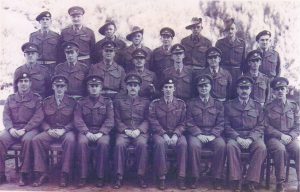
Rear: Henry Woods, Ernest Bradley, Fred Keys, Sgt Dansfield, Alan Cox, A. Baldwin, … Baxter’ … Lehmann
Centre: Mick Neat, Bill Turley, Mick Rooney, Bill Adams, Phil Chaloner, Max Stone, Fred Summers
Front: Chick Jarman, John Lewis, Ron Garland, James Harrison, Max McCrackan, D.A. Danson, Bob Wilson, Roger De Groote
Staff responsible for training the very early courses were mainly experienced World War 2 officers from various streams and the cream of senior Non Commissioned Officers also most with Second World War experience from the Regular Army, such was the importance placed on OCS as an officer producing institution.
These simple arrangements suited the short courses, but obviously needed modification for the extended subjects and two-class, three-platoon structure of the COC in 1955. More instruction was handled on a class and syndicate basis rather than sub-units, instructors became more specialised, then following the two-company restructure the previous year, separate formal groupings were created in 1966 designated Infantry Wing and Advanced Training Wing; company commanders also doubled as senior instructors of the wings under a commanding officer-chief instructor. Subsequent retitlings saw Field and Military Arts Wings, then Field Training and Advanced Training Wings plus Drill and Professional Development Wings and a Training Development Cell, finally separate from the Corps’ two-company structure.
The comparative stages of organisation shown in Table 4 (5) tend to characterise the progress of any hierarchic organisation from simplicity to maturity to over-ripeness, which has led modern management theorists to develop other than hierarchic models for organisational development. On the other hand purely functional models have their own vices, so the organisations of the early years capitalised on a hybrid system’s benefits of simplicity and functionality. And while there is no doubt that the changing composition of curricula, classes and numbers required the hybrid structure to be expanded and revamped from that of a training company to one appropriate to a multidisciplinary academy, increasing specialisation in any field naturally results in increased numbers overall, increasingly sophisticated structures to match specialist groupings and a more unionised approach to organisation and work. But while development of a more leisurely pace than the frenetic one of the early years was both inevitable and desirable, the end product was hardly justifiable in modern management terms. The instructional student-staff ratio moved from eight to one in 1952 to four to one in 1985 (6): there would be little suggestion that the later graduates were twice as effective as those initial ones, and the staff was still under considerable pressure of work with the added functions which were progressively manufactured and added to their normal duties. Unfortunately such an example to the formative minds of the students was less than likely to instil ideas of spartan standards to guide them in their later service.
Officer Cadet School Staff – December 1985
Training Staff

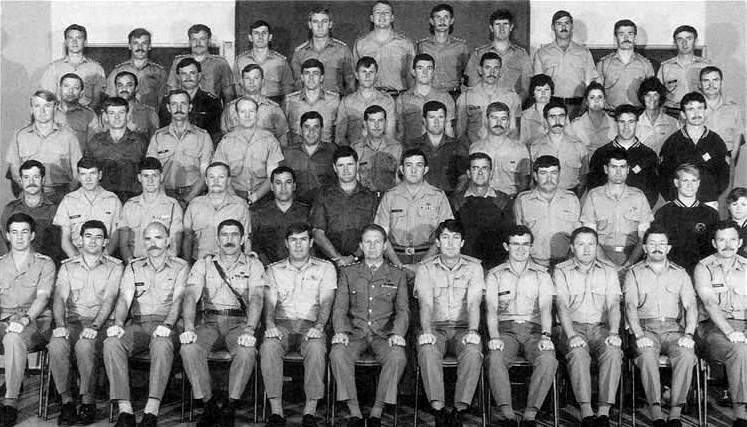
Capts D. Stuart G.Y. Foote E.G. Paterson J.C. Dittmar P.M. Standen K.D.H. Felsche D.J.R. Smith P. McCarthy WO2 R.E. Bryce Capt E.F. Czerw
Capts T. Uil G. Yacoub C. Abbott M.P. Sampson R. W. Dobbie Sgts P.F. Castley G.E. Smith B.M. O’Donnell Capts F. Conlan D.G. Cole W02
C. Schmierer Sgt E.G. Howard
Capt M.D. Southwood WO2s D. Sullivan S. Remin R. Bell B.M. Defreitas R. Hollingdrake G. Brady Sgts M.R. Bishop R. Anderson Cpl J. Miles Sgt G. Slattery
WO2s R.A Stillwell K.F. Schoene Y.K. Leith R. Hall WO1 H.J. Macown WO2s M.A. Caughey R. Slater J.C. Horton H.L. Smith J. Maple
Cpls M.D. Anderson L.J. Cruise
Capts D.C. Ryan M.L. Corne P.W. Pearce WO1 K.S. Wendt Lt Col J.W. Langler Col P. Davies Majs K.M. Byrne G.J. Stone J.G. McBride B. Barletta Chap P. Woodward
Headquarters Staff
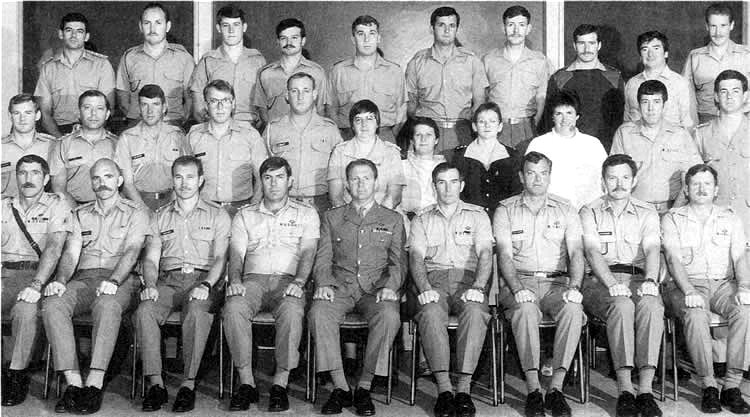
Capt M. Corne Cpl M. McCluskey LCpl Watkins Pte Labouchardiere Cpl Wright Sgt R. Henczel Sgt M. Kennwood Pte Reardon Mr P. Johnson Sig Barwick
Capt KS. Fraser Capt T. Uil WO2 K Schoene Sgt P. Adams WO2 H. Daley Capt M. Sefton Mrs N. Derrick Capt L. Croft Mrs F. Rowles
WO2 C.G. Woodhouse Capt D. Ryan
WO1 K.S. Wendt Capt P.W. Pearce Maj D. Buchanan Lt Col J.W. Langler Col P. Davies Lt Col E. Titley Maj R.J. Shillabeer Chap P. Woodward WO2 F. Harris
Administrative Staff – The engine room of Portsea
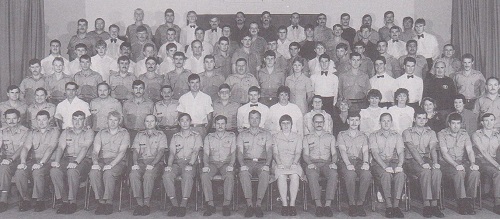
It took a substantial number of staff with a wide array of skills to run the Portsea community: personnel administration, pay, stores, quarters, catering, messes and clubs, grounds and facilities maintenance and security.
Part military, part civilian, these employees ran what was a in effect a small, self-sustaining town.
Staff and Cadet Control
The original structure of the School was that of a normal course at an Army school, and indeed the initial approach was not so much an officer cadet school but rather that these were members of the regular army undertaking a course, those who dropped out returning to civilian life or to their units to serve out their regular army engagements in the ranks. In consequence staff members were simply the instructors, the cadets the students on a course. However mutual learning and internal authority structures have long been recognised and used in the Army as one of the most effective ways of transferring knowledge and developing responsibility and self confidence, with the added bonus of much of it happening outside normal training time. This was hardly possible under the six month courses except to the minor degree of those cadets with previous service assisting those without prior military experience. But although cadet NCOs were appointed part way through the courses, their expertise in topics ranging from military inter-relationships to mess etiquette, and innate levels of responsibility, was uneven enough to be hardly a sound basis for mutual education. It fell to the instructional staff officers and warrant officers to inculcate standards and foster knowledge in each successive course from a virtual zero base and without the extended contact of living together outside instructional periods. So while the dedication of the staff ensured that this had been done as effectively as possible, it needed the introduction of an overlapping class structure to provide the mechanism to pass on knowledge progressively as and when it was needed and could be beneficially absorbed.
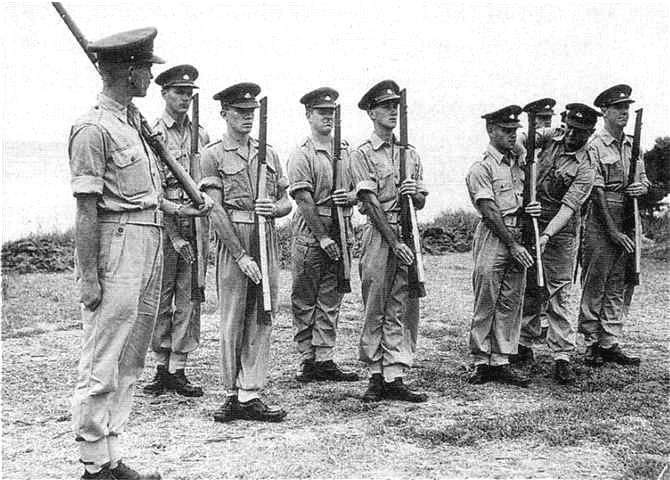
After the initial rush of simply running a course with staff instructors pushing in skills and knowledge as fast as they could, it was recognised that the students had to be turned out of the School as instructors themselves, so a progressive shift to mutual instruction was instituted.
This was difficult during the early stages when the student instructors were themselves learning what they were themselves having to teach, however staff instructors were able to assist in both aspects simultaneously. It was one of the aspects in which the army training system was so adept, and enabled the compression of curricula to remarkably short periods, though at the cost of high intensity commitment of both staff and student.
J.F. Miller teaching the present arms to R.C. Watson, L.A. Power, K.F. Houley, P.B. Roden, I.B. Bates, R.B.McN. Donaldson, A.J. Corboy, is assisted by staff instructor W02 M.M.I. Ronney.
Photo: L.A. Power
The other factor was that of control. Under the single-class system cadet rank was less than universally respected. With the novelty of the first appointments there was some early attempt to use it for internal disciplinary purposes but the general attitude was more akin to first amongst equals, and more appropriate for ceremonial parades. As a result it had been to a large degree them-and-us as far as both staff and students were concerned, but with the advent of the dual class system, the senior class in control of the daily running of the cadet body outside formal training periods, and a junior body to both rule and provide example to, a new attitude was engendered: an instructor noted ‘the metamorphosis of certain members of the senior class, who find themselves now on the side of authority, and who defend the established order to the abandonment of their former reprehensible habits’ (7). This was of course a classic social case of an aristocracy establishing a squirocracy to rule the lower classes and coincidentally accept the odium for the control measures which had to be employed, and there are always those who are ready to take on the mantle of authority, which was indeed the very reason that they were at Portsea seeking commissions in the army. Not that this was always appreciated by their less eager colleagues, or indeed their seniors, one CSM referring to those from his junior classmen who were obviously aspiring for rank as ‘suck eggs juniors’. However the privileges of carrying out this service at OCS were few – a leave book instead of applying for a leave pass, for some a private room and others exemption from extra drills (8).
In the single-course days there was no internal structure in the cadet body until the end of the first month when selected cadets returning from their first short leave period were issued with non-commissioned rank and some degree of internal control was attempted. There were two reasons for a rank system: the standard one of having an internal chain of command through which to pass instructions and responses which was entirely valid; the other was to provide formal continuous leadership opportunities and practice in exercising control for trainee leaders, which was a mixed bag. If the object was to turn out all graduates at the best standard, and the cadet appointments were believed to foster the desired characteristics, it would have seemed that the each cadet should have been rotated through the main appointments rather than give the more senior experience to just a few. All graduates were commissioned at the same level, and all were presumed to have equal opportunities for career advancement; indeed some of those without higher cadet rank turned out to be amongst the better performers later in their commissioned service, but this blind spot in equal opportunity went unremedied.
Even when the classes were small, fewer than half the senior classmen were endowed with rank, the others being given the title of Senior Officer Cadet to provide some status and distinction from members of the junior class. But with expansion of numbers entering the School in the early 1960s, it became necessary, in order to provide camouflage for this gross discrepancy in training opportunities offered, for the creation of more appointments other than the original ones of company sergeant major, company quartermaster sergeant, platoon sergeant and section commander. Section second in commands as lance corporals were added and then the structure was more than doubled in 1965 with formation of the battalion of two companies plus a battalion sergeant major and battalion quartermaster sergeant. But much more was needed when there were a hundred cadets in each class, being partially met with the creation of numerous extra positions which reflected an oriental sharing of work: each company headquarters had a corporal clerk, battalion headquarters a sergeant, there was a journal corporal and later another journal representative in each company, an under officer president and six on the mess committee, sports sergeant and librarian corporal as well as a duty officer and NCO and other less formally identified tasks (9).
Faces of Command
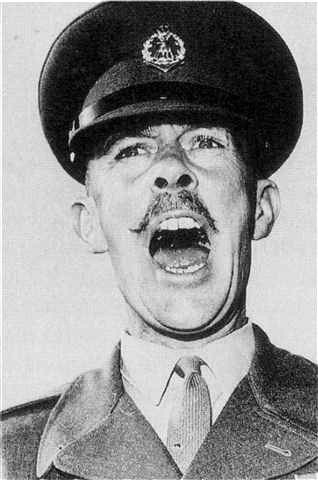
The immediate image of control lay in that of the Regimental Sergeant Major – here WO 1 L.E. Brennan, while that within the Company of Officer Cadets was the Company Sergeant Major then Battalion Sergeant Major – here SUO D.M. Cantwell.

Each had a function to perform in the training and control of the officer cadets which went beyond simple parade ground orders. The staff controlled instruction, the student non-commissioned officers the internal running of the student body.
RMC Archives
Ranks allotted for the basic appointments within the Corps during various stages of the School’s existence were (10):
| Appointment | Army Non-Commissioned Rank | Designations at OCS |
| Battalion Sergeant Major | Warrant Officer Class 1 | Senior Under Officer |
| Battalion Quartermaster Sergeant | Warrant Officer Class 2 | Under Officer |
| Company Sergeant Major | Warrant Officer Class 2 | Warrant Officer Class 2 Company Sergeant Major Under Officer |
| Company Quartermaster Sergeant | Staff Sergeant | Staff Sergeant Colour Sergeant |
| Platoon Sergeant | Sergeant | Sergeant |
| Section Commander | Corporal | Corporal |
| Section Second in Command | Lance Corporal | Lance Corporal |
| No appointment Senior Class | Private | Senior Officer Cadet |
| Junior Class | Private | Officer Cadet |
Just as there was a large senior class for whom some task had to be found, significant increases in staff under the wing structures saw a parallel in the officer appointment hierarchy where burgeoning numbers of instructors were available and had to be found a position which gave them an avenue of personal responsibility and commitment to the cadets. From the earlier situation under the sub-unit structure where company and platoon officers were also instructors, the reverse applied where the instructors in the training wings were appointed as company commanders and platoon commanders, plus platoon officers allotted to each section as guidance officers. Even this could not soak up the numerical talent available, the officer cadet supernumary appointments being matched with a Journal supervisor and commanding officer of the cadets’ mess; coaches were also found for each of the sports teams, which in the second half of the School’s existence were numerous and varied indeed. In addition it was necessary to cover the usual plethora of extra-regimental appointments inherent in any unit: fire, safety, regimental audit boards, boards of survey, stocktaking, internal audit, welfare; office bearers, committee members and supervisors of messes and clubs. It is not a new thought that resources expand to fit the available space as was the experience when the School started, or that spaces are created to accommodate available resources as it finished. However Portsea was ever an unusually busy place, and more hands made lighter work for a previously much harassed faculty.
The degree of control exercised by the staff was a moveable feast. From the early approach of treating the function as a normal regular Army course, with officers as platoon commanders and warrant officer instructors fostering the cadets, the two class system developed at its best into virtual internal control, though this was to a large degree dependent on the ability of the staff to let this happen. Anyone in a position of responsibility, who finds his function being usurped by superiors whom he cannot persuade otherwise, will automatically reduce his efforts either in pique or on the presumption that his full efforts are not required, and indeed cease to act with full responsibility himself. While it was incumbent on the staff to give full rein to the potential of the student body to control itself, it was too often the case that overenthusiastic staff members intervened, in the process handing out exaggerated punishments for trifling offences. Fortunately a late move to make staff warrant officers platoon commanders was stillborn as this would have stifled the cadet platoon sergeants, but the number of inspections which could be carried out was potentially unlimited, and in some cases approached that; commanding officer, company commander, platoon officer and adjutant in succession inspected rooms and, together with instructors during periods of tuition, held a continual sword of Damocles over cadets’ heads, hardly an environment calculated to promote learning and development of personal motivation (11).
Guidance as well may have moved into overkill. The establishment of guidance officers for all cadets was in concept a valuable way of counselling students and ensuring that they did not fall behind and enter the failure zone without timely notice and direction. Warrant Officers were for a time used to counsel junior class cadets, but this was changed for all guidance to be by officer staff who from week 10 were required to interview their protegees fortnightly (12), though the necessity for such frequent counselling in other than extreme cases is debatable in any context: twenty such sessions in a year are each interspersed with two weeks of apprehension for all but those whose rate of progress does not need such counselling anyway. It was a delicate decision to balance the need to intervene effectively in good time against the counter-effects of over-intervention, as was calculation of the degree of latitude for the COC to run its internal relationships with a minimum of intervention.
Internal Relationships
There was a dichotomy in approach to senior class treatment of the juniors. With some validity the seniors believed that the new entrants had to be quickly brought to a realisation that they were at the bottom of the ladder, and had to reemerge in the OCS system on their future rather than past merits. There was a countervailing approach from the staff that they had to build up cadets’ self esteem and confidence, so the meeting point of this and the limits on the seniors was the point at issue. A principal means of the latter was the guidance officer system where a two way dialogue between officer and cadet was directed at early identification of problems and encouraging timely resolution. On the other side bastardisation within the COC was officially outlawed but always latent and sometimes virulent. Undergraduates world-wide have a habit of exuberance which often spills over into mental and physical abuse and Portsea was no exception. Indeed with the disciplinary and coercive powers available to the senior cadets, it went beyond the usual peer pressures, and there was ample scope for the harmless and humourous to degenerate and escalate into a more vicious mode. While various ex-cadets and staff stoutly proclaim there was no bastardisation at OCS in their time, there are also others who testify otherwise.
Accelerated Induction – 1960
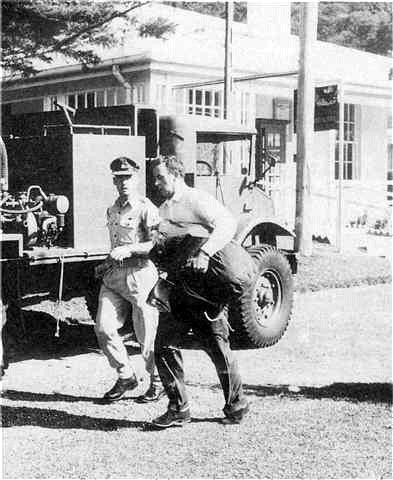
A new cadet carries his clothing issues back to his room at the double, encouraged by his senior class mentor.
While there would have been little real reason for such haste at this juncture, justification for this pressuring was that it brought home to the uninitiated the sharp focus of everything at speed, necessary to meet the tight timings of the course programme.
While such minor hazing was in itself fairly harmless and also to a minor degree constructive, the accumulation of such activities in the initial few days presented a major hurdle for new entrants, some simply dropping out, one taking to his bed crying for two days, then staging a solid recovery.
The system was changed in July 1969 to having Q issues placed in cadets’ rooms, while the practice of cadets being required from arrival to march at recruit pace with arms swung shoulder high was discontinued. The eventual solution was a two week segregation of the new entrants to learn the basics under staff control before they were exposed to their cadet seniors.
OCS Scrapbook 1960
Some of the activity was tolerable and tolerated as being both educative and humourous. Requiring juniors to learn facts about the army was useful in passing on details which could never be covered in any syllabus, and was one of the payoffs of the overlapping class system. Other questions such as ‘how much water does the tank on the hill hold?’ were of no merit, but at least vaguely amusing to those who knew the tank in question was an armoured vehicle. Another manifestation was the Green Hornet named for the detective thriller, a senior cadet dressed in green cape, gas mask and amplifier to give a Darth Vader intonation, who would move amongst the newly inducted junior cadets lined up outside their rooms at night, dispensing pearls of wisdom on their lowly status and responsibilities. Yet another was the practice of ‘leaps’ which was early imported from RMC, where cadets were obliged to dress for mess parades from leaving the shower inside five minutes, and then two minutes. This arguably beneficial exercise in rapid changes into standard orders of dress necessary for tight syllabus timetables was extended at Portsea to practice in changing dress in all sorts of improbable combinations, which on the one hand kept the speed and precision element and on the other introduced an element of the ridiculous. Other examples of mindless humour included waving at night to passing ships, marching an imaginary centipede along the power line between accommodation blocks, shouting at pine trees lining the driveway to the oval and loudly extolling the virtues of football teams favoured by seniors. Although banned under the 1969 liberalisation policy together with stupid questioning, questions in the mess and marching juniors around at accelerated pace, similar or equivalent diversions returned and persisted. To the ultra-serious and super-critical it could smack of harassment, to most recipient cadets junior class training was generally tolerable, at best combining necessity with humour, at worst an immature but unavoidable imposition (13).
Other internecine activities were of a more catholic type. The process of bishing was not restricted to visitations on the junior class, and in its fully developed form of the birthday bish was more a sign of attention, the absence of which would leave a member wondering why his friends had forgotten him. And while the practice of transporting all the contents of a cadet’s room to another location were often inflicted on the junior class, there were no rank barriers in who where the victims; this was further extended at 28 Days To Go where the junior class had some impunity in inflicting discomfort on their seniors. But there were some forms of harassment devoid of humour, rationale and sense of human dignity, which was the real dividing line across which lay classic bastardisation. That these occurred remains clearly in the memories of many graduates from different times, and may be even more so with some of those who did not graduate. There were none of the periodic scandals as occurred at RMC when commandants neglected to keep control of excesses for whatever reason; commandants at OCS certainly took care to be aware of what was going on and keep limits on it as best they could.
A Binned Room, 50 days to go -1960
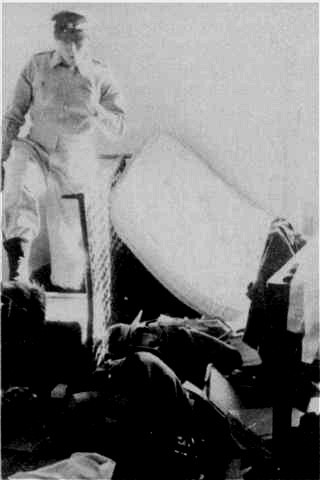
Another way of getting at juniors was to devastate their rooms. With the effort necessary to fold, stack and display clothing and equipment in the meticulous and precise way required by School Standing Orders, this was a harsh penalty indeed to levy on another cadet.
It was, of course, a two-edged activity, as nothing stopped juniors inflicting the same on their seniors after they had gained the confidence to do so. As with other escapades such as involuntary immersions in the bay and contents of rooms being shifted to other inconvenient locations, the senior classmen had to look to their own well-being as much as the juniors. Consequently this became a factor controlling excesses and tended to steer such activities into the genre of black humour, rather than terrorisation of helpless juniors by sadistic seniors.
OCS Scrapbook 1960
With the advent of overlapping classes came a father and son fostering system which should have created an empathy between both parties and often did, but was sufficiently suspect in its general application to be terminated in July 1969 as part of the liberalisation programme. It then came back to section commanders and second in commands to educate their junior class members, but this too became suspect, leading to the segregated junior class induction camp in 1983 to get new entrants past the most vulnerable stage with a firmness devoid of harassment. In between times various moves were made to limit or ban junior class training, as by Col S.T.G. Coleman in 1961 which was quickly reversed when the results of non-intervention by the senior class became apparent, while the official strictures of 1969 still left more subtle avenues for use (14). In any social organisation there will always be problems in defining relationships without throwing out the baby with the bathwater, as is evidenced today by national attempts to control various aspects of so-called discrimination and harassment. Letter of the law in virtually indefinable human relationships produces unwelcome counter effects: it remained for commandants to lay down general standards and use their staff and senior cadet hierarchy to exercise as much control as was necessary to maintain the spirit of that policy.
Leaps Competition – 1983
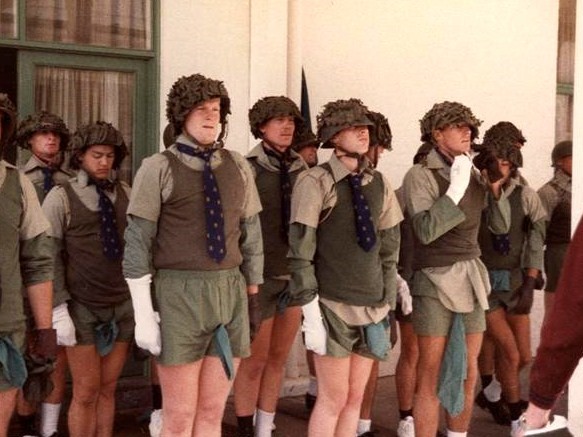
A leap was a quick change from one order of dress to another to meet the School’s tight timetable. This led to the junior class being practised in these quick changes, which in time moved on to unusual variants of mixed dress, then to inter-unit competitions.
When the basic purpose of leaps was overtaken by gamesmanship, it had moved from its intended functional use and had to be viewed closely as to whether this form of hazing went too far towards bastardisation, or fell under the heading of undergraduate hi-jinks.
As in all such things, it had to be considered in context of the whole spectrum of what was going on at the time: whether this was one of a whole array of oppressive activities, or part of the collegiate knockabout interactions.
Participants: M.C.Y. Wong, B. Arrowsmith, L.C. Atkinson, B. Homewood, J.B. Knight.
OCS Scrapbook 1983
Staff at Portsea fulfilled a variety of functions vital to the operation of the academy. Of primary importance were the instructional staff members who had the core task of teaching the students the necessary basic skills, imparting the theoretical and practical knowledge and skills, developing physical and mental stamina, and moulding the potential officers into men ready and able to assume the junior leadership of the army. As co-workers were the ancillaries – education officers and psychologists, and supporting them was the administrative staff running the internal economy of the School.
It was recognised from the beginning that a high quality product from OCS required not only a high quality of officer candidate but also the right stamp of instructor. Initial staffing comprised an experienced chief instructor and company commander Maj R.S. Garland MC assisted by a young RMC graduate Lt G.G. Jarman, with two platoon commanders who were AIF veterans assisted each by four experienced warrant officers. Harrison commented that his initial instructional staff had four out of five infantry officers and asked for a better spread. As the nature of the course flowed from one of training a basic regimental officer to a broader one of equipping graduates for a long career in the profession of arms, so did the perception of the type of instructor needed, and as the range of subjects expanded and deepened so did the scope of instructional talent widen, with eventually representatives of all the major arms of the service, together with specialists from education and psychology. Further depth for overseas students was provided with instructors from New Zealand and temporarily Capt A.R. Huai from Papua New Guinea (15).
Instructional Staff
It was both inevitable and desirable that graduates would return on the staff. First was 2Lt W.J. Murray from the third course who appeared as adjutant in 1955, followed the same year by 2Lt C.D.K Haywood from the first course. Instructors were slower to appear as, with the spartan staffing of the School, it was imperative that they have in-depth experience, however as expansion of the school was accompanied by a wider rank range of officer instructors, so the opportunity to bring in more junior officers opened the avenue for more graduates. Capt C.A. Cunningham became artillery instructor in 1959 and, in a parallel move, Capt B.W. McFarlane became the first OCS graduate as an instructor at RMC 1961. Thereafter it was commonplace that a high proportion of OCS graduates occupied instructional positions, reflecting the increasing proportion of the Australian Staff Corps which they occupied (16).
Finding a commandant was a different matter, as it required a mature officer and, desirable as it might have been to have the home grown product, the army was in no hurry to force the pace, given the influence he had on selection of candidates and commissioning of over half the officer entrants to the army. In 1978 Col B.G. Florence AM MC, a December 1952 graduate, became the first to return as commandant, his appointment being announced during the 25th reunion of graduates at the June 1977 graduation; his successor Col G.D. Burgess MBE was from the December 1955 class. However the same variety did not carry to the position of chief instructor and commanding officer – these were carefully selected to carry the critical tuition function. It was late in the piece when graduates attained enough experience, seniority and operational credentials, it being possible to fit in two only, Lt Cols R.W. Bleakley and P.M. McDougall, before appointment of a graduate commandant, when it was wisely decided to avoid an incestuous mix of both appointment from the one source; infantry officers were invariably selected in keeping with the basic theme of the course, relying on a full range of other disciplines being represented in the broad spectrum of the faculty.
Present and Future Commandants – December 1955
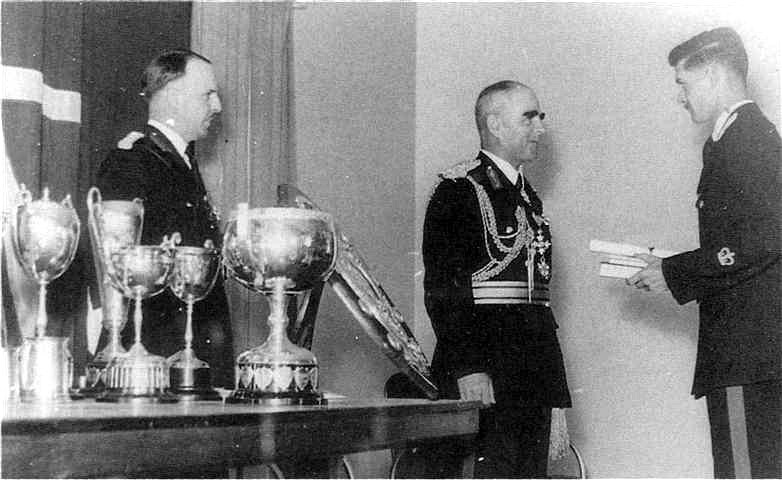
Chief of the General Staff Lt Gen H.G. Wells CB CBE DSO presenting prizes to senior graduate CSM G.D. Burgess after conclusion of the graduation parade of the first full year course on 15 December 1955.
Assisting him with diplomas and prizes is the second commandant of OCS Col T.F. Cape. Burgess became the second OCS graduate to return as commandant, after Col B.G. Florence, in 1981.
OCS Scrapbook 1955
It would be difficult to pick any particular appointment amongst the instructors which influenced events or individual cadets more than another. Just as commandants were interventionalist and immanent or the reverse, so were the varied members of the instructional staff according to their personality and to the role they set themselves. Different cadets had different perceptions of who impressed and influenced them, and who were perceived to be shallow, self opinionated or attempting to impose their own version of bastardisation. Some found their company commander either inspirational or the source of their troubles; adjutants, being remote from the mainstream of activities seemed to appear mainly as harbingers of trouble. Various corps or national instructors and guidance officers could act as patrons of their kind, able to provide such favours as supplying otherwise unavailable copies of past examination papers or lobbying for appointment to cadet rank. Physical Training Instructor WO1 R. Keane, contrary to the usual image of physical torturer, had a great following as one of the instructors who most helped cadets to survive and succeed (17). Many found inspiration in various RSMs and other warrant officer instructors, most often in field training where their long experience allowed them to be helpfully informative and supportive of the cadets, as opposed to the more inquisitorial role of the officer instructors. Each cadet had direct contact with an array of instructors and found in them what he either needed or dreaded, according to how he was progressing; their characters and future approach to service and to the men they commanded were to a large degree a product of the quality of that influence.
Commandants
Commandants of officer training establishments hold a unique place in the leadership of the army: the nature of officer production left no alternative to delegating to the commandant virtually absolute powers. Not that even despots act without counsel, and commandants were no exception. On selection boards another general staff officer and a psychologist assisted in determining suitable applicants, although one OCS commandant, Col J.F. McDonagh, during a dispute on a doubtful candidate, sharply advised his second on a selection tour that he would make the final decision on who was accepted, though also conceding that those who gave him the greatest cause for concern often had little difficulty in completing the course; but the point being made was that he did indeed have the final say as he had the final responsibility. This responsibility then carried through in consequent decisions on cadets’ progress towards graduation, and here again was a consultation process in reviewing the progress of officer cadets, eventually formalised into a Board of Studies, on which the senior instructional staff formally assisted the commandant in assessing whether individuals were making satisfactory progress, should be warned of potential failure, terminated or finally graduated. The Adjutant General at Army Headquarters and his successor the Chief of Personnel-Army at Department of Defence (Army Office) reserved the decision to remove a cadet from the School – though this was largely a formality other than an occasional problem involving overseas students – and recommend that the Governor General commission successful cadets. But the reality was that ultimately there was no viable alternative to the commandant being entrusted with the decision to graduate a student and recommend him for commissioning (18).
Visiting Chief of Staff – 1957
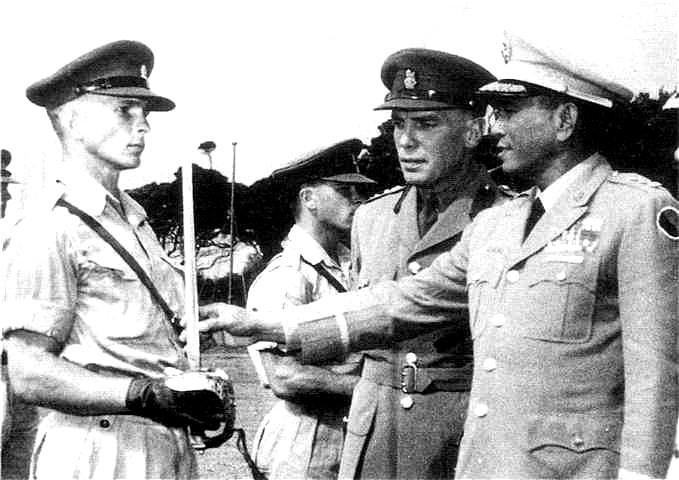
The Philippines delegation to the SEATO conference held in Australia in 1957 was interested in finding regional avenues of extending the scope of their officer training rather than relying simply on their former colonial mentor. Lt Gen Arellano, Chief of Staff of the Philippine Armed Forces visited the School with his delegation, here accompanied by commandant Col D.R. Jackson.
Subsequently, Philippines students commenced a long term association with Portsea, a total of 38 graduating between 1960 and 1982.
Photo: OCS Scrapbook 1957
Each commandant had his own style of shaping the operation of the School and the makeup and training of the graduates. While curricula may have had a similar composition on the surface, the content and emphasis on both curriculum and extracurricular activities produced a considerably different approach. Not that here again the commandants acted in other than a directional role, as the chief instructor and his staff developed the concepts into detailed syllabuses, training programmes and activities, which the instructors then implemented. The impact that individual commandants made on the cadets was varied: high profile incumbents such as Harrison, Ochiltree and Coleman in the first decade made their mark in quite different ways, the one strong and perceptive, another urbane and persuasive and the third aggressive and impulsive. Some operated in the background, the senior/chief instructor taking the limelight either by default or dominance, and a similar pattern persisted in the later years where the cordon of greatly enlarged staffs could produce a byzantine seclusion from hoi polloi: some were most apparent in post-Board of Study interviews and parades while others were pervasive in their presence. Photographic evidence, or the lack of it, as well as the testimony of the students tends to illustrate the profile of individual commandants.
Sporting Prize Presentation – Portsea March 1974

Commandant Col D.M. Butler DSO presenting sporting trophies at ISCAM 1974 to Sgt G.D. Harris.
The main face to face contact with the cadets was their interaction with instructors, assistant instructors, inspecting officers and their guidance officers. Sporting and social events and presentations allowed commandants to make contact with their charges on a less formal and considerably more agreeable occasions than such negative meetings as post-Board of Study warnings.
Some commandants also made their presence felt during training activities where this could be achieved without detracting from the instruction, others lived in apparent seclusion from the cadets’ point of view.
Photo: OCS Scrapbook 1974
Other pointers give an indication of their wider approach to their command beyond their core function of producing worthwhile officers. Harrison, Cape and Jackson were committed to establishment and consolidation; Ochiltree was dedicated to producing a rounded graduate and keeping the School running in a low intake era; Coleman and Bates coped with the major expansion; Bogle and McDonagh were initiators in liberalisation and development; Butler in reworking and stabilising the School and training structure; Cole and Florence in balancing standards against a continuing high wastage regime; Burgess in rebalancing excesses of assessment with effective training; and Davies had the final task of preparing for amalgamation with RMC. All were obsessive in modifying the course to make the best of the time available both quantitatively and qualitatively; promoting the development of better facilities and amenities for both cadets and staff; preserving and improving the environment; and fostering and maintaining a continuing relationship with the community on the Mornington Peninsula (19).
Regimental Sergeant Majors
If there is a single member at long-course officer training establishments which most impresses the officer cadet it has to be the regimental sergeant major. Often a remote figure in large units, in the cloistered environment of an organisation such as OCS the RSM has the potential to provide both the example and driving force for self discipline, endurance and motivation. It was a retrograde step at both OCS and RMC when the introduction of drill sergeants replaced the regular interplay, between disciplinarian with a human face and impressionable young men, with teachers of drill movements dedicated to producing automotons. If the RSM had retired to the remote image, a valuable component of a student’s development would have been wasted, but the astute selection of men to fill the job ensured that they recognised their developmental function, and involved themselves in a wide range of activities which enabled them to maintain constant contact and influence on character development of their charges. WOl K.S. Wendt encapsulated his ethos in telling his charges ‘you are here to learn to be leaders, not followers’, and set himself to help achieve just that (20).
RSM R.R. Richardson MM – Shepherd’s Hut, 1974
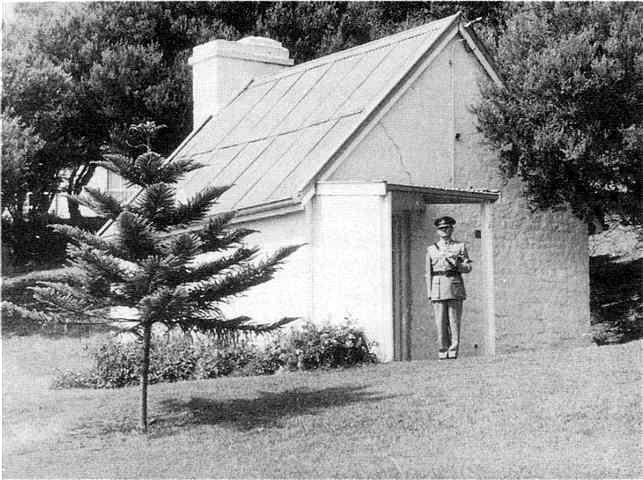
Archetype of an RSM, immaculately dressed with pace stick, eagle eyed in front of his office overlooking the parade ground, the breed came from the most successful men who were not just parade ground soldiers but had won their spurs in operational units, as soldiers and non commissioned officers.
OCS changed its RSMs at regular intervals, though many had had several previous postings as assistant instructors, and as a known quantity were welcome back at the school, while they themselves welcomed the posting.
As one of the top jobs for an RSM much sought after in the army, it might have attracted the best from any corps, but it remained mainly in the hands of infantry warrant officers.
Photo: OCS Scrapbook 1974
None stayed long enough to become an institution or a legend as happened at RMC and other Commonwealth colleges, though some had several prior tours at OCS as assistant instructors and others were commissioned as quartermasters and stayed on in that role. Richardson commented on his 14 year total ‘if there isn’t a war on, what better place is there to serve in than Portsea?’ They were each consummate actors, with an exterior of steel, but like all good RSMs able to sense when breaking point had been reached and introduce an interlude of light relief. The following selection is typical of them (21):
Paddy Brennan: owner of a large dog, invited the young sirs to the Sergeants’ Mess to teach them the art of drinking and, after considerable imbibing, swore on parade the next day that the dog had driven him home.
Jock Richardson: correcting a cadet on parade in his characteristic accent ‘Move yourrr boot … not yourrr boot mon, the boot of yourrr rifle’.
Tom Waters: during a sword drill session lambasted cadets as ‘something I seen in a pirate movie’: this became a stock expression in the COC culminating in a pirate attack on the parade ground from a Hobie Cat during 28 Days to Go.
Ron Cox: with badly distorted tapes substituting for lack of a band, he used his pace stick as a baton to conduct and beat time; in one crescendo, moving backwards he tripped on the dais and, falling flat on his back bounced up, kicked a hole in the side of the dais and shouted ‘not a word … not a single bloody word’. No one did – at least until after the parade.
Sam Hassell: noticing cadets being taught the slow mark time were having difficulty in keeping their balance stood for a prolonged period with his knee raised, saying ‘if an old man of 60 can do this, you can’.
Presentation of Commission – December 1983
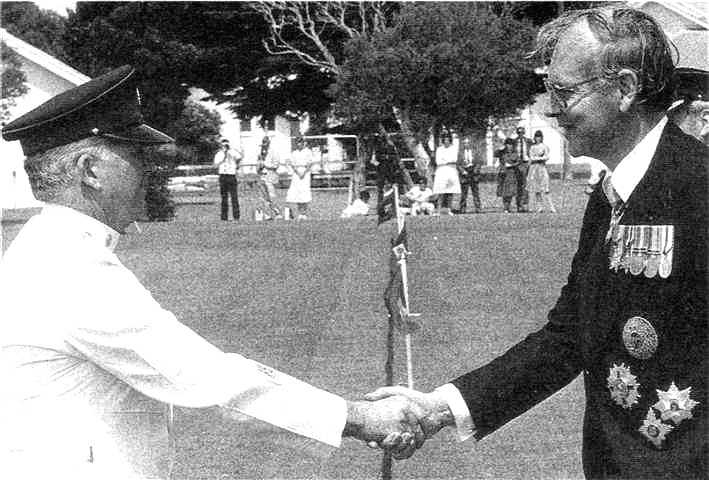
Governor General Sir Ninian Stephen AK GCMG GCVO KBE presenting a commission to RSM WO 1 B.A. Hassell after the graduation ceremonies, enabling him to remain at OCS as quartermaster.
He was not a graduate of OCS, being commissioned under the system of direct appointment of senior soldiers which provided the means of using their talents as administrative and technical officers without the humbug of experienced senior soldiers having to attend a long course as did young soldiers and civilians.
The problem was that many in this stream were long on military ability and experience and short on administrative expertise and temperament, which created problems for those who found difficulty in adapting to the routine and patience required in such employment.
RMC Archives
Support Staff
As was the case with any army unit the nature of support staff was varied in trade and quality. Like any other major unit, and particularly those outside main bases, OCS was provided with a range of staff to quarter, supply, feed, move, pay, maintain and communicate. Controlled by a major in charge of administration assisted by a quartermaster, assistant quartermaster, regimental quartermaster sergeant and a warrant officer caterer, the administrative trades included carpenter and joiner, administrative, pay and technical clerks, cook, draughtsman, driver, general and hygiene dutymen, library assistant, medical assistant, mess supervisor, painter and decorator, printing assistant, rifleman, steward, storeman, switchboard operator, tailor, transport supervisor, typist and watchman. The corps represented were RAAC, RAA, RAE, RA Sigs, RA Inf, RAASC, RAAMC, RAAOC, RAAEC and AACC, a polyglot lot to be welded together, themselves administered, kept out of trouble, and delivering the service which their special skills provided (22).
Quality of the staff was very mixed. While major field units found most of their tradesmen from within their own ranks and selected and trained them for the tasks, a non-standard unit was given its quota from those nominated by corps personnel managers, who very obviously tended to look after their own corps units first. Particularly in the less skilled areas, the standard could be low indeed, especially in the 1950s when poor recruiting levels, in a regular army struggling to support National Service training, led to acceptance of lower standard recruits which sowed trouble for the future. Initial RQMS of Portsea W02 A.E. Neate, in a talk given on his departure in 1956, described his charges as ‘three out of every 10 had been an ack-willie merchant’ and cooks who ‘couldn’t even boil water’, yet he was proud to have made it all work (23). This was of course the very essence of a well run army unit: that not having the benefit of being able to select staff from a range of applicants, to make the best of what is available, which is the true test of a manager and leader.
This did not inhibit commandants from requesting and demanding a better quality of tradesman, however they were very experienced officers and understood that their problems merely mirrored those of the army as a whole, as they had found in previous commands. Their efforts were therefore directed not to general gripes but towards solving specific problem areas as they arose. An early concern was simply the scarcity of numbers, but as this improved they were able to send members on courses at army schools to improve their capabilities, and as all good commanders do, they somehow made time to meet their obligations to these soldiers by conducting military refresher, range and promotion training and qualification. But on the debit side for many reasons staff turnover was high and shortages endemic throughout the army, and OCS was not immune to this, leading commandant Col D.R. Jackson to point out in mid-1957 that the School faced paralysis within a month unless urgent replacement action was taken, a crisis averted only by Headquarters Southern Command approving the employment of civilians as a stopgap, although difficulty in obtaining and retaining suitable mess stewards and kitchen hands continued to be a problem (24).
A real problem arose with the expanded intakes from 1963 when the army was also coming to grips with the two-year full time duty National Service scheme and beginning the long haul of supporting the heavy commitment to operations in Vietnam. While additional administrative staff were willingly authorised, the filling of the positions with effective personnel was another matter. National Service training both absorbed Regular Army instructors and support staff and in return provided National Servicemen as the mainstream lower ranks for not only operational units but also for administrative positions. While the army selected only about half of the 20 year olds who were ballotted in, and in consequence their maturity and capability was quite adequate, the two year term meant that, after six months recruit and technical training, and allowing for their discharge procedures, they were trained but not experienced and were employable for less than eighteen months, engineering a loss of their services just as they has gained a good level of proficiency, and their replacement by another barely qualified tradesman. Another factor noted by commandant Col H.G. Bates was that he was getting soldiers unsuitable for field force units, and while he could accept those with medical disabilities as being appropriate for a static unit, those unsuitable on other grounds would be just as unsuitable for a unit like OCS (25).
There was also a compounding factor in the doubling of the Regular Army: officer and non commissioned officer promotion was accelerated to fill the vacancies created and so experience was diluted at each rank level, causing units to seek higher ranks in positions in order to get experienced occupants, which in turn created more promotion and dilution in a vicious cycle which meant that the supervisors of the inexperienced basic tradesman were themselves light on experience, as well as there being shortages at each rank level. The support staff was of course largely the unseen side of the unit, most noticeable when things went wrong, but as essential to its functioning as was the instructional side. But problems were for solving, and the great strength of the army system was its ability to make things work and extract the best out of the resources available, which epitomised the administrative as well as the training operations of the School.
Cadet Views of Staff Members
Regimental Sergeant Major
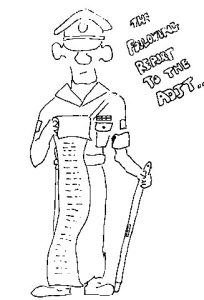
OCS Journal June 1978 |
Education Officer
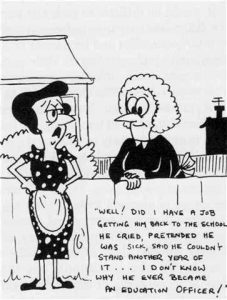
OCS Journal June 1972 |
References
- Ollif L. Colonel Best and Her Soldiers, p63, 106, 197-8.
- AAB2453/1 R556/1/1 of 22 December 1964; see Table 17.
- AA B2453/1 R7231111 OCS Reports 1972-3.
- AA B2453/1 234/4/5 of 20 December 1965.
- OCS Establishments; B2453/1 R133/1/16 Brief on OCS 15 November 1965; RMC Archives Miscellaneous OCS OCS Graduation Parade of 16 November 1973 Appendix 1 to Annex C; R274-3-5 of October 1983 Appendix 1 to Annex C .
- OCS Establishments.
- Letters A.R. Roberts; Journal of the Officer Cadet School 1955, p11.
- OCS Journal 1976, p13; 1955, p11.
- OCS Cadet Handbook, p2C1, 4-1.
- OCS Cadet Handbook Chapter 2, p2C1.
- AA B2453 R78/4/1 of 12 June 1981; Letters E.J. Ellis, D.J. Gillot, I.K. Hughes, L.A. Power.
- OCS Staff Handbook, para 1114.
- Letters F.D.L. Greenway, A.A. Nikolic; AA B245311 RI3312/8 of 20 September 1969, 4 April 1970.
- Letters R.R. Player; Interviews D.N. Maddocks; AA B2453/1R133/2/8 of 20 September 1969, 4 April 1970.
- AA MP89711 27/32/9 S Comd 106/8/1142 of 15 October 1952; MP927 106/8/1142 of 15 October 1952.
- Letters C.A Cunningham, B.W. McFarlane.
- Letters R.L. Bricknell, O.M. Eather, RL. Sayce.
- OCS Standing Orders Chapter 9; Manual of Personnel Administration Annex B to Chapter 52.
- AA B2453/1 R723/1/1 OCS Reports passim.
- VideoAn Officer and a Lady.
- Letters F.D.L. Greenway, J.A. Harriot; Interviews P.R. May, M.L.F. Spencer, S.P. Collard.
- OCS Establishments.
- RMC Archives Miscellaneous OCS Valedictory Address W02 A.E. Neate
- AA B2453/1 R723/1/1 OCS Reports passim.
- AA B2453/1 R723/1/1 of 17 June 1965.